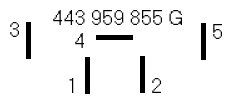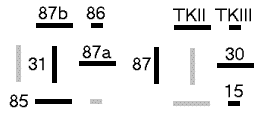 |
Express Power Windows |
 |
This is the story of my quest for one touch up and down power windows for my car. My ideal result is to be able to tap either switch in either direction and have the window open or close all the way, or hold the button down for as much travel as I want. As it turns out, the control units available in the USA are for one touch down only, and always open the window all the way, no matter how long the switch is depressed. You must tap it the other way for a partially opened window. In Europe there is a control unit which provides an up and down function, I am less familiar with its exact modes of operation, and since I am unlikely to get a set of these it doesn't matter for now.
First let me describe how our most commonly available window switches work. Here is a rough breakdown of the varieties I have here to work with:
| Part Number | Switch Style | Year & Model | Comments |
| 431 959 855 E | Paddle, round pins, no lamp | 80-83 5k auto | Mounted on front of cubby behind hand brake |
| 431 959 855 D | Rocker, round pins | 80-83 5k standard | Mounted on plate forward of shift lever |
| The following are the much more attractive slim line rockers, with 1/4" flat spade connectors: |
| 443 959 855 D | lamp on "up" half | 85-on 5k etc? | Easily cleaned. Polarity reverse of two below. |
| 443 959 855 F | lamp on "down" half | ditto | Not cleanable |
| 443 959 855 G | lamp on "down" half | ditto | Blue base, metal springs, not cleanable |
I have more extensively analysed the later (443) versions, so this information applies accurately to them. I'm sure the early ones work the same way though. These are all five pin units, from 4 door cars. Pins 1 and 2 are the output to the window motor (or in the case of driver's switches for passenger windows, output to the passenger's switch). Pins 3 and 5 have the same polarity input but are not identical, and pin 4 has the opposite polarity input.
| View from bottom of switch showing pinout |
| 1: Output to window motor or slave switch |
 |
| 2: Output to window motor or slave switch |
| 3: Ground or master switch output |
| 4: 12 V protected power supply |
| 5: Ground or master switch output |
This polarity is a pain because the 443 switches are lit by LEDs, which are diodes of course. On the D switches, pin 4 is grounded, and on the F & G switches, it is at 12 V - so while these switches are interchangeable functionally, the wrong type will not light up - the diode will be backwards.
I am using the 443 959 855 G in my car. As far as I can tell these are interchangeable with the F, except for the spring on the side. Which is easy to break off if it's not needed. I think the spring is for mounting from the outside in door handles for passenger windows, whereas the non-spring version is for mounting from below in the plastic switch panels in drivers doors (5k) and center consoles (4k & Coupe). I like this switch because the light is where you touch it to lower it - typically the first time somone wants to know "where is the window switch" that is what they want to do, and I can just tell them to touch the picture of the window...
These comments are specific to this switch - reverse all the input polarity comments to apply it to the 443...D. The reason for pins 3 and 5 both being grounded is as follows: When the switch is not being actuated, pin 3 is fed directly to pin 1, and pin 5 to pin 2. Actuation connects one output to pin 4, causing the motor to run. This also sends "signal" along to the passenger window switch (if it is one), which is made the same way. The "local" passenger window switch then passes this input to its pins 3 & 5 to its output pins 1 & 2 unaltered. For its own function, it has a dedicated power wire (in the case of 443...D, a local ground - which is better, who knows?) attached to pin 4 and gets its grounds from the upline switch.
So why does all this matter? Good question.
Here is the way the US version of the power window control unit works: it has inputs for unswitched 12 V from a circuit breaker, ground, ignition (via the Load Reduction Relay), and both front door switches. It provides the 12 V and ground connections to pins 3,4, & 5 of the switch. It is connected in parallel with the window motor at switch pins 1 & 2.
| View from bottom of control unit 443 959 257 A showing pinout |
| 15: signal from LRR |
 |
87: 12 V to window switch pin 4 |
| 30: 12 V from circuit breaker | 87a: Ground to window switch pin 3 |
| 31: Ground | 87b: Ground or 12 V to window switch pin 5 |
| 85: signal from window switch pin 1 | TKII: signal from left front door switch |
| 86: signal from window switch pin 2 | TKIII: signal from right front door switch |
What it does: power is available from ignition on until one door is opened. When the switch is actuated in the down direction the signal to motor is picked up by the control unit and it substitutes a 12 V signal for the ground normally going to pin 3 - which, since you have let go of the switch, is being passed along to pin 1, and the motor keeps going. The control unit uses a timer to stop doing this, it would be nicer if it used some sort of current sensing. It also stops if you tap the switch in the opposite direction. This is the thing that fascinates me about the European version - if it has one touch up and down, there must be a way to run the window partly open or shut since tapping the switch to stop it would run allt he way the opposite way!
I'm not sure yet whether, one, there are more things going on at the ouput on the control unit (it wouldn't be necessary), and two, whether the control unit inputs sense more than just the altered (ground replaced by 12 V) signal at the window switch output.
My initial decision was to use the two I have, with both pins 3 & 5 and 1 & 2 reversed, to give me one touch up on both windows. This would be more useful in my opinion, since typically when lowering a window all the way I'm not doing anything demanding (ie approaching Dunkin Donuts' drive through window, approaching toll booths, etc.) and it's easy to use the switch to get the window down. However, often raising the windows is something I want to accomplish with a single tap (ie accelerating out of toll booths, preparing to leave parked car) because I am concentrating on other tasks as well.
Anyway, that would be easy. In fact, following my notes scrawled six months before, I finally did this installation when I had the console out for some other reason. They work exactly as planned. I have them set up to run from key in (get the signal from the seat belt warning relay socket) to key out and door open. But I have been thinking... if the way this all works is to simply send a reversed polarity signal to one switch input (in this case 12 V not ground), maybe I should use a third window type switch, or even just a momentary single pole double throw mini switch, to trigger the control units, and let one control the ground terminal for "up", pin 5, and one control the ground terminal for "down", pin 3, on both switches. Then I would have normally controlled window operation at the regular switches, with another switch that could drop or raise both windows all the way at the same time with a single touch.
I'm also thinking that this description of how the control unit achieves its task will prompt attempts by me and others to develop a simple device that does the same thing - a timed (or current sensing) SPDT switch triggered by an input changing state momentarily would be the base for some interesting experimentation!
This whole escapade could also be used as the basis for engineering a system whereby when the driver's door is locked the windows both close automatically...
I also hanker to replace both my window control units with the European only module, which gives you express up and down. The only problem is that they are expensive... Any European listers out there who want to dig a couple up in junkyards for me? The part number is 441 959 257 D.
That's all, for now, folks.
|